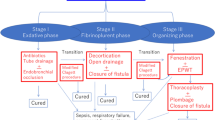Abstract
Purpose
The conventional management of a post-pneumonectomy (PPE) and post-lobectomy empyema (PLE) necessitates an open window, wound packing, frequent wound debridement, and prolonged hospitalization. We studied the feasibility of outpatient therapy in this patient population using the vacuum-assisted closure (VAC) therapy system.
Methods
From September 2005 to November 2007, six patients with PPE and PLE with or without a bronchopleural fistula underwent outpatient therapy using a VAC system. After debridement and closure of the bronchial fistula, a VAC system was applied and the patient was discharged. The patient returned for debridement under anesthesia and VAC replacement every 7–10 days. Once the pleural space was cleaned, the residual space was obliterated, and the wound was closed over suction catheters. Of the six patients, two developed recurrent infection after the closure that required repeated VAC dressings and flap closures.
Results
The outpatient use of the VAC system in patients with PPE and PLE avoided the need for any daily painful dressing changes and significantly decreased the total length of hospitalization and the time to closure of the empyema space, and thus increased the overall patient satisfaction.
Conclusions
Our results suggest that outpatient VAC therapy of PPE and PLE is feasible and beneficial.
Similar content being viewed by others

References
Song DH, Wu LC, Lohman RF, Gottlieb LJ, Franczyk M. Vacuum assisted closure for the treatment of sternal wounds: the bridge between debridement and definitive closure. Plast Reconstr Surg 2003;111:92–97.
O’Connor J, Kells A, Henry S, Scalea T. Vacuum-assisted closure for the treatment of complex chest wounds. Ann Thorac Surg 2005;79:1196–1200.
Matzi V, Lindenmann J, Porubsky C, Neuboeck N, Maier A, Smolle-Juettner FM. Intrathoracic insertion of the VAC device in a case of pleural space empyema 20 years after pneumonectomy. Ann Thoracic Surg 2007;84:1762–1764.
Varker K, Ng T. Management of empyema cavity with the vacuum-assisted closure device. Ann Thorac Surg 2006;81:723–725.
Morykwas MJ, Argenta LC, Shelton-Brown EI, McGuirt W. Vacuum-assisted closure: a new method for wound control and treatment: animal studies and basic foundation. Ann Plast Surg 1997;38:553–562.
Morykwas MJ, Argenta LC, Shelton-Brown EI, McGuirt W. Vacuum-assisted closure: a new method for wound control and treatment: clinical experience. Ann Plast Surg 1997;38:563–576.
Author information
Authors and Affiliations
Rights and permissions
About this article
Cite this article
Al-Mufarrej, F., Margolis, M., Tempesta, B. et al. Outpatient management of post-pneumonectomy and post-lobectomy empyema using the vacuum-assisted closure system. Surg Today 40, 711–718 (2010). https://doi.org/10.1007/s00595-008-4096-9
Received:
Accepted:
Published:
Issue Date:
DOI: https://doi.org/10.1007/s00595-008-4096-9



